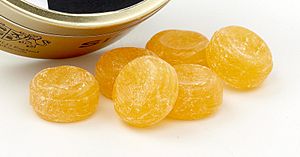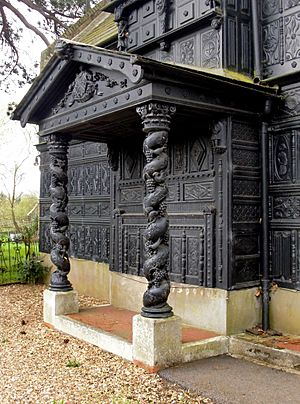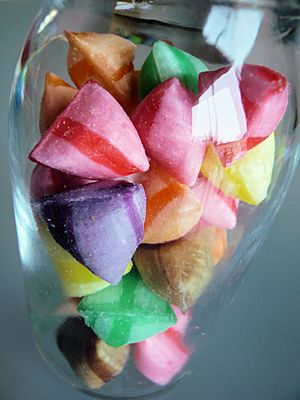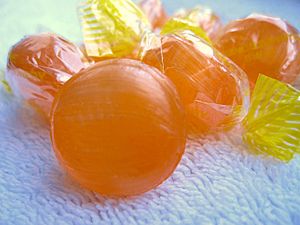Barley sugar facts for kids
Barley sugar is a classic type of hard candy. It's usually yellow or orange and often shaped like twisted sticks. This sweet gets its special taste and color from an extract of barley. It feels and tastes a lot like other hard candies or even hard caramel candy.
Contents
How Barley Sugar is Made

How is barley sugar made? There are a few ways! The U.S. Food and Drug Administration (FDA) explains that heating sugar to different temperatures changes the candy.
If you heat sugar to about 160 degrees Celsius (320°F), it melts and then hardens. The surface might look cloudy because tiny sugar crystals form. But if you heat it even hotter, to about 185 degrees Celsius (365°F), it becomes a thick liquid. If this liquid cools down quickly, it stays clear and transparent. So, "barley sugar" doesn't mean there's only one way to make it.
Some candy makers use cream of tartar in their barley sugar. Others use corn syrup to make a harder, clearer candy.
Today, some companies make "barley candy" without any actual barley. They use artificial flavors instead. However, the FDA suggests that a product should only be called "barley sugar" or "barley candy" if it truly contains barley.
The Sweet History of Barley Sugar
The First Barley Sugar: Sucre d'orge

Before the 1700s, sugar was often seen as a medicine or a spice. The most traditional way to make barley sugar is called Sucre d'orge.
A nun named Elizabeth Pidoux from a Benedictine convent in Moret-sur-Loing, France, is often given credit for the first recipe. In 1638, she was trying out new medicines. She mixed sugar with barley water, and that's how this special candy was born! This early barley sugar was made by boiling refined cane sugar with barley water and regular water.
Sucre d'orge became very popular with the French nobility. It was an important way for the convent and the town to earn money. This continued until the French Revolution, when the abbey closed.
Later, another group of Benedictine nuns returned to Moret. The recipe for Sucre d'orge was passed down to them. They started making the candy again in 1853. Production continued until the 1970s.
In 1970, Sister Marie-André shared the recipe with a candy maker named Jean Rousseau. His family worked hard to keep the tradition alive. In 1995, they opened Le Musée du Sucre d'Orge. This is the only known barley sugar museum! It helps remember the history of barley sugar in Moret-sur-Loing. Since 2012, the local town council has managed the museum.
In 1997, the Rousseaus also started a group called the Confrérie du Sucre d'Orge des Religieuses de Moret sur Loing. This group helps support the making of the traditional candy. The Rousseau family continued to make the candy until 2012. Now, another company, Des Lis Chocolat of Nemours, has the right to make Sucre d'Orge des Religieuses de Moret.
Sucre d'Orge des Religieuses de Moret was often sold in boxes. The small candies were shaped like pyramids, called berlingots. They were marked with a heart, a cross, and the letters "RM" (for Religious of Moret). This type of barley sugar was also made into small spiral sticks. Because of its twisted shape, the name "barley sugar" is sometimes used for twisted columns in buildings or twisted legs on furniture.
Changing Tastes in Candy

The 1700s and 1800s saw big changes with the Industrial Revolution. More sugar was made from sugar beets instead of sugar cane. France and England were often in conflict, not just in wars but also over trade. Napoleon, for example, encouraged using sugar beets to challenge Britain's control over sugar cane.
By the 1860s, people's candy tastes were changing. A writer named Henry Weatherley noticed that there were fewer shops selling boiled sugar sweets in Paris. In London, barley sugar had been "one of the oldest sweets made." It was once a big attraction to watch barley sugar being made. But these old favorites became less popular.
In England, new sugar candies with many different flavors started to replace traditional barley sugar. The term "barley sugar" began to be used for many similar types of hard candy. Sugar candies were also popular in Germany. Recipes for these sweets traveled to North America with settlers from England, Scotland, and Germany.
Molded Barley Sugar
During the 1700s, people started using metal molds to create candies in different shapes. These shaped candies were known as both barley sugar and clear toy candy. By the 1800s, these molded candies were a popular Christmas treat. They were especially loved in Germany, England, and parts of North America. Pennsylvania, with many German immigrants, became a center for this tradition in North America.
A company called Dorothy Timberlake Candies in Madison, New Hampshire, made molded barley candies. They added different flavors to them from 1971 to 2009. Their collection of old candy molds had over 13,000 different shapes!
Barley Sugar Recipes
An old cookbook from 1723, called The cooks and confectioners dictionary, has a recipe for barley sugar that actually includes barley. It says to boil barley in water, strain it, then add the barley water to sugar that has been boiled to a "caramel height." Then, pour it onto a marble stone rubbed with olive oil. Once it cools and starts to get hard, you cut it into pieces and roll them into sticks.
However, by the 1800s, many "barley-sugar" recipes in cookbooks didn't use barley at all! For example, an 1829 recipe for "barley-sugar" twists, tablets, and drops used sugar, lemon, vinegar or alum, and "any essence you choose." An 1850 recipe used sugar, water, and lemon. An 1880 recipe used sugar, water, and egg white. Isabella Beeton's famous Mrs Beeton's Book of Household Management (1861) also used egg white and suggested adding saffron for color. A modern recipe often uses sugar, water, lemon, and cream of tartar.
A cookbook from Chicago in 1883 included a recipe specifically for molded candy, called "Candy for Christmas Toys, Etc." An older recipe from 1818 for clear toy candy has also been shared again.



